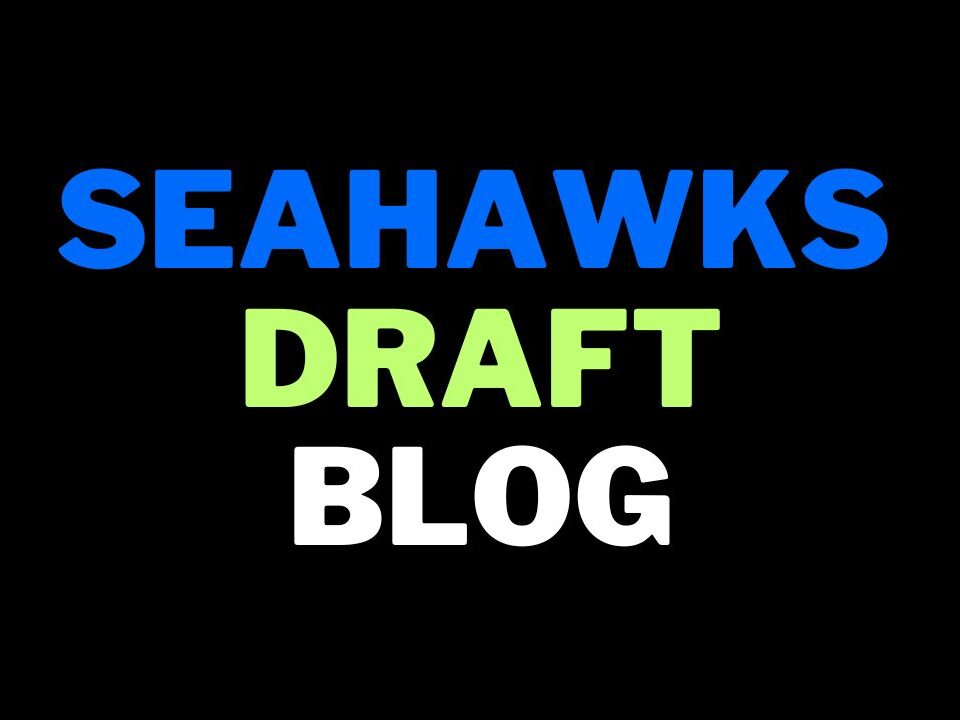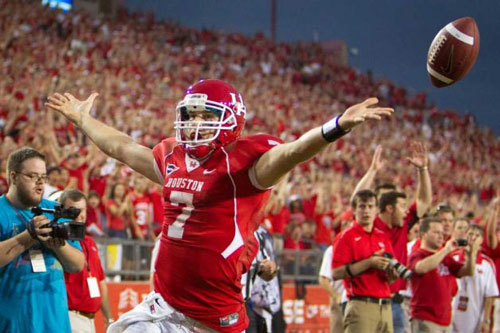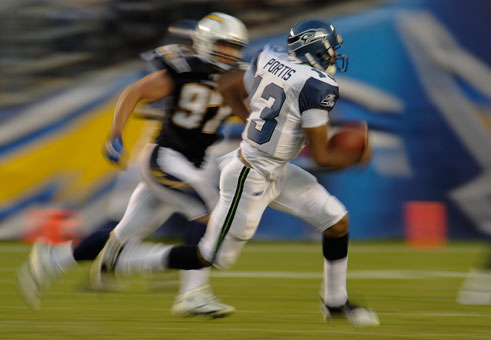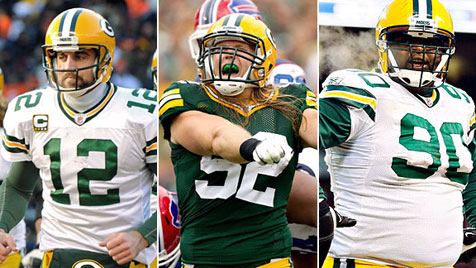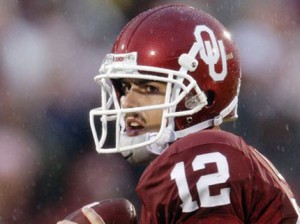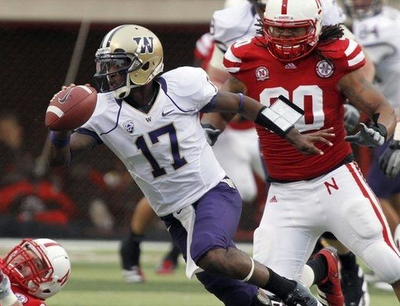
by Kip Earlywine
I’ll be honest. I don’t know when exactly it was, but at some point last offseason I heard the phrase “point guard quarterback” for the very first time. Its human nature to react negatively to things we don’t understand, and so like many others, my disposition towards the idea began at a low point. Using a basketball position to describe a quarterback? What kind of nonsense is that?
Many other Seahawks fans were confused by the term, and yet they talked about it. Quite a lot actually, without ever bothering to find out exactly what the definition of a point guard quarterback really is. This led to an epidemic of misunderstanding. To many Seahawks fans, even right now, a point guard quarterback simply means a signal caller with mobility. Initially, I was one of those people. But eventually I became unsatisfied with such a murky definition. If a point guard quarterback is just a mobile one, then why not just say “mobile quarterback?” Why invoke the point guard position in basketball? Surely there must be a reason.
After a bit of research, I came to learn that the point guard analogy is actually a two way street, as point guards in basketball are often referred to as “the quarterback” of the basketball team. This makes a lot of sense, as some of the greatest point guards, guys like John Stockton and Gary Payton, were more dangerous for their ability to assist than to score directly. Yet their ability to score themselves was potent also. Their threat to pass to teammates sometimes opened up chances to score themselves, and being a credible threat to score helped open up the pass. Another thing about point guards, is that some of the best are very short by NBA standards. John Stockton is perhaps the best point guard of all time, and he’s only 6’1″. Steve Nash might be the best active point guard, and he’s 6’3″. Gary Payton was 6’4″. The average NBA player is 6’7″, and it was actually slightly higher in Stockton’s time.
So how does this analogy relate to this NFL? A point guard dribbles the ball up just past mid court, holds up fingers to “call a play”, and as the offensive series evolves, he will eventually have a choice between passing and shooting. Passing the ball to a more open team-mate is often better for scoring points. However, occasionally a defender will not take the threat of the point guard shooting seriously and play the point guard soft. If a wide open shot is available, a point guard will often take it. Concisely speaking, a point guard prefers to pass, but will shoot if an open look is given. In the NFL, the “pass” portion of the analogy represents passing the ball, and the “shoot” part means to run. A typical point guard will take his fair share of shots, but he will pass multiple times for every shot he takes.
A critical part of this analogy is that unlike some NFL quarterbacks, a point guard quarterback will not lock onto a primary receiver all game long. Just like how an NBA point guard doesn’t just pass the ball to his best player, but the other 4 members on his team; a point guard quarterback distributes the ball to as many receivers, at as many locations, as possible. Doing so stretches a defense, and can help open up the #1 wide receiver when it counts. In boxing, a common strategy is to attack where the gloves ain’t, meaning that if he’s guarding his face, attack the body, and when he guards the body, attack the face. This kind of strategy wears down opponents and ultimately proves more effective in tough fights than just going exclusively for face hits.
As far as the shoot portion of the analogy, a good point guard must also be able to shoot the ball at least somewhat well, because if he shows no threat to do so, defenders can just swamp him without any worries about the risk that entails (being blown by for an easy layup). That’s an exaggeration for effect, but essentially, its tougher to defend two things than one. That said, shooting is always the 2nd option, unless the point guard really is the best player on the team (as it was for Payton and Nash for parts of their careers). A point guard quarterback is the same. A 5 yard run is better than throwing the ball out of bounds, and if a defense gives it to you, you slide and take it.
So to clear up misconception #1, a point guard quarterback is not a run first position, as the ability to run the football is important, but far less important than the ability to pass the ball. A lot of people assumed that Jake Locker would be a Seahawk had he reached the 25th pick, since he averaged over 100 carries at year at Washington. As it turns out, Jake Locker was much lower on Seattle’s draft board than many thought (through an inside source, Rob revealed Seattle’s quarterback draft board earlier this year and Locker was quite low on it). Further, the Seahawks war room actually erupted into smiles and applause the moment that Locker went well ahead of them, just as they did when the Rams selected Robert Quinn. Does that sound like the reaction of a disappointed group? Jake Locker could run, but he tended to have tunnel vision with his receivers, as attested by Jermaine Kearse and Devin Aguilar having several monster games, but almost never at the same time. He was also a big play quarterback with a 54% completion rate and below average pocket presence. If just being a mobile quarterback was enough, then Locker was that in spades. But clearly it was not.
So if the position is not run first, why is mobility emphasized? There are two reasons. The first is that a viable threat to run is yet another way to stress out a defense, and while the point guard position was designed to make a quarterback’s life easy, it ironically (or fittingly?) makes defending it a total headache. If a point guard type checks all the boxes, he can make a defense worry about defending both sides of the field, defend every running back, tight end, and receiver near equally, and have to cover short, intermediate, and deep in near equal parts, plus defending against a quarterback running himself, and also defending against effective play action fakes and non-fakes (the running game is a crucial part of a team that runs this type of offense). Like the boxer analogy, the ability to run is like adding an extra body area to hit. The 2nd and perhaps more important reason for the mobility requirement is elusiveness. The point guard role is not structured but fluid and instinctive; improvisation is required on many plays. Great pocket presence might be the biggest asset of all to a point guard type. He must feel pressure and use his mobility to buy extra time both outside the pocket and within it. Jeff Garcia, when playing in his natural point guard role, was a pretty effective quarterback and huge reason for that was his penchant for completing passes at the very last instant after buying time with his feet. An elusive quarterback can turn sacks into completions, which is why the good ones excel so much at building long drives.
Another misconception is that point guard quarterbacks are game managers. This is almost true but not quite. They are similar in that both types of quarterbacks strongly emphasize possession plays over big plays. Point guard quarterbacks are known for long drives as are game managers. Both game managers and point guard quarterbacks stress having few interceptions. The difference is that point guard quarterbacks actually have balls about it. A game manager type rarely throws the ball more than 10 yards down the field and typically features a below average yards per attempt. A point guard type will pass short, intermediate, and deep, all to keep the defense as honest as possible. Andrew Luck is an effective point guard type. His YPA is 9.50, one of the best in college football. Michael Vick (under Andy Reid) is an NFL contemporary of the role. He had a 8.1 YPA last year (7.9 so far in 2011), which was good for 4th best in the NFL. A game manager role is given to quarterbacks with limited ability. A point guard role is similar, but given to players with a lot of natural ability.
For this reason, high accuracy has added importance for a point guard quarterback. Incompletions and sacks lead to unfavorable down and distance, and the point guard system is built to reduce both. This is critical, because a point guard offense is built around maintaining drives more than big plays. Due to the instinctive, less structured nature of the role, and its high emphasis on spreading the ball, comfort checking multiple reads is also further emphasized. Though the point guard role is designed to make a quarterback’s life easier, it is actually quite demanding in terms of having skills. Having elite measurables is optional, but having poor innate talent with the fundamentals is not.
Finally, I mentioned before that some of the best point guards in the NBA have been much shorter than the average NBA height. Similarly, many notable point guard quarterbacks have below average height as well. A typical NFL quarterback is 6’4″. The prototypical Steve Young is 6’2″. Michael Vick is 6’1″. Jeff Garcia is 6’1″. I think the reason for this is that in the NBA, point guards typically play far away from the basket, so height is less of an issue. In the NFL, height is less of an issue since point guard quarterbacks move so much in the pocket that they can usually find windows to look through, even if their lineman stand a few inches taller. By no means do I think the role cancels out the need for certain height requirements, I don’t think a 5’8″ quarterback would succeed even as a point guard type. But I do think that mobility behind the line helps cancel out the extra couple inches of height. And of course, there is nothing wrong with having a tall point guard type. Josh Freeman is 6’6″. Its just that for whatever reason, most point guard types tend to be shorter. Perhaps its because their height is what put them in that system to begin with. Or because physical elusiveness in taller people is uncommon.
Regarding Keith Price:
Some of these concepts I knew from the research I did earlier this year, but it was when I watched Keith Price take over for Jake Locker about a month ago that the concept fully came into focus. In almost every way, he is the perfect example of what a point guard quarterback is.
First, let me be clear about something. This essay is not about discussing Keith Price: NFL draft prospect. Its merely to highlight Price as an example of what a true point guard quarterback looks like, without having to venture any further than Lake Washington for evidence. So with that in mind, consider this comparison between two pro-style college quarterbacks:
Quarterback A: 69.4% completion rate, 8.62 YPA, 21 TD, 4 INT, 177.9 rating (sacked 11 times in 6 games)
Quarterback B: 71.3% completion rate, 9.50 YPA, 18 TD, 3 INT, 180.5 rating (sacked 2 times in 6 games)
Pretty close huh? The first quarterback is Keith Price, and the second is Andrew Luck. Both quarterback’s play the point guard role in a similar offense, in the same conference, in the same sub-division of that conference. In fact, they actually play against each other on national television this weekend. There are issues comparing the performances of college quarterbacks in many cases, but as both Stanford and Washington play very similar schedules and basically run the same kind of offenses, it makes a comparison worth making. I’m hardly the only one to notice the similarities, today’s copy of USA Today made a similar statistical comparison between the two.
Luck has a small edge in completion rate, YPA, and interceptions, but Price has a small edge in touchdown passes and has been sacked five and a half times as often. Eleven sacks allowed in six games is actually not that bad, and its more of a testament to Price’s elusive nature than his unimposing line. By contrast, Andrew Luck throws behind perhaps the best line in all college football, with two members currently being projected in the mid to high first round of the 2012 draft. Its just silly that Andrew Luck has one of the best interception per pass rates in football, yet has more interceptions than sacks taken. Luck is having his best year yet: one of the very best pro-style system seasons in college football history. And yet the unheralded redshirt sophomore Keith Price is right there with him in his first six games since being named the starter- by far the best 6 game stretch by any Husky quarterback or any Husky offense in its history. In half a season, he’s already 5th all time for TDs in Huskies history for a single season. The record is 28, and he’s on pace for 45 or 46.
That’s not to say that Price can hold water to Luck as an NFL prospect. Please do not interpret this analogy as such. If anything, the wide gap in physical attributes only furthers a point I wish to make, that a great point guard quarterback can put up elite production without all the elite measurables.
And besides, I didn’t really make this post to talk about production, though its certainly been outstanding out Price’s part. I made this post to illustrate what a real point guard quarterback looks like. And Keith Price is just that. Moreso than even Andrew Luck. More than just about any quarterback I’ve seen. So lets get to it:
For starters, Keith Price is 6’1″ with a weight listed at 200 pounds (listed at 195 some places). Height is not a real concern, since as stated before many successful NFL point guard types were around that height. Price is outstanding at maneuvering behind his line, and he seems to see his targets just fine because of it. His line may not be very good, but they are NFL sized. Height will not be an issue for Price in the NFL. His weight though… its a major concern. Most NFL quarterbacks sit around 225 pounds, and 220 is considered to be somewhat fringe, although point guard types are typically lighter weight. Michael Vick is 215, as was Steve Young, and Jeff Garcia was only 205.
Those players were effective in the role, but they were also no stranger to injuries. This is true for Price as well. He’s played hurt in all six games to date, namely with two bad knees and recently a tweaked ankle. I’d be exaggerating if I said Price comes up limping after every hit he’s taken, but not by much.
That he’s put up the numbers he has in the context of his injury bug is astonishing, and also evidence that mobility is not the end all of a true point guard quarterback. Price has got decent wheels when healthy, but he’s only had 15 net rushing yards so far in six games. That’s fewer rush yards than passing touchdowns. Despite this, Price’s ability to be elusive in the pocket has remained mostly intact, which shows how much more valuable elusiveness is than running ability as a point guard quarterback.
Bottom line though, Price needs to add a more weight to his frame, and cut it out with the constant injuries. His frame is far from maxed out, and i think he could probably get all the way to 220 if he really wanted to. I’d say he needs to at least reach 215 if he wants to be a first round pick some day.
Price’s arm strength seemed suspect early in the year against Eastern Washington. Like Tarvaris Jackson, Price was more of a “tosser” than a “thrower,” emphasizing accuracy and catchability over speed of arrival. That changed as the season progressed, and after the learning experience that was the Nebraska shootout, Price seemed to perfect this pass throwing: arriving with decent zip but while maintaining accuracy and a soft catch. That progress crested in last weeks game against Colorado, when Price had four touchdown passes (to four different targets) in just the first half, and was pulled shortly after due to the blowout score. Price has developed an impressive deep ball, which rivals Jake Locker’s despite the gap in arm strength. This was evidenced by a 70 yard touchdown pass to beat Cal in the 4th quarter (50 in the air) to Chris Polk (!).
Price’s body language is a little tentative; he’s not as hesitant as Tarvaris Jackson, but I’d say he’s on that side of the spectrum. Still, almost every throw he’s made has been money, and he’s only thrown 4 interceptions in 170 attempts (1 per 42.5). Recently against Colorado, he ran full no huddle to devastating effect. Price is an instinctive quarterback and really shines even more in a fast paced offense. Its hard to criticize Price for not looking aggressive when the results suggest the opposite.
His throwing mechanics are pretty good. He has a high release point, a quick arm motion, and a very nice compact tuck move that makes his pump fakes deadly effective. His footwork needs work, and often I’ll catch him making throws flat footed with his feet spread out pretty far. Its actually not very different from Jake Locker’s footwork in the pocket, which a lot of scouts believed was the source of his inaccuracy. Well, accuracy hasn’t been a problem for Price. I wonder if that speaks well of Price or poorly of his predecessor?
Price is generally outstanding on his execution, with a very convincing play action and good deal of comfort throwing on the move. I haven’t charted left vs. right yet, but given how ridiculously good he’s been, I’m not expecting much of a split.
Price is a highly accurate quarterback, perhaps even more so than his 69% season rate indicates. For example, against Utah he completed 73% of his passes, and of the eight total incompletions he had, four of those were drops (three by Devin Aguilar alone). His completion rates since opening Pac-12 play: 76%, 73%, 75%. His passes are generally either in the middle of the receivers body or leading them perfectly if its a vertical route. I think its worth emphasizing how much the soft touch on his passes helps him, other than the mini-drop fest at Utah. He’s suffered fewer drops than Jake Locker, who threw the ball with about as much subtlety as a bazooka.
Price has excellent pocket presence, feeling pressure without having to see it, and doing more than simply stepping up in the pocket, but moving just inches out of harms way constantly to buy time. I wouldn’t say his elusiveness is at an elite level, but its probably on par with Andrew Luck’s.
Price regularly checks through multiple reads with ease, which is a fairly rare attribute in a college quarterback. During the Colorado game, Price even used his eyes to deceive defenders on two of his touchdown passes. The first was when he appeared to stare down a target on his left, freezing the safeties, then immediately turned and hit Jermaine Kearse for a wide open touchdown up the middle, almost without looking first. Later, he would sell a stare-down in the middle of the field, then attempt to quick hit Polk on the left. Polk wasn’t wide open, so Price added a great pump fake for good measure, before throwing a perfect pass that only Polk could catch.
I want to give a big shout-out to qbsacker5394, who posted each of Washington’s three Pac-12 games on Youtube (he also has the other three games if you check his channel). His videos show every notable play from the broadcast, compressed into 13 to 14 minutes. Not every play unfortunately, but still good for getting an idea. I’ve already seen the games live, but for anyone that wants to get a better look at Keith Price (or RB Chris Polk, TE Austin Seferian-Jenkins, or DT Alameda Ta’amu) themselves, they should definitely check his videos out.
This has become one of the longer posts I’ve ever done, and I still have things to say about Price. But I’ll sum it up as such, Keith Price is playing at a high level, and in every way that is essential to the point guard quarterback, he’s excelled. I’d consider him a somewhat polished quarterback that has a few things to work on, and I think its encouraging that he’s gotten better with each game as the seasons gone on. Keith Price is a somewhat unlikely option for the Seahawks, as will probably declare in 2013 or 2014, and for the love of God I hope this front office has their quarterback by then.
But I must say, watching Keith Price’s first six games has been instructional- witnessing a point guard quarterback play almost the same exact offense as Seattle’s, from a Pete Carroll disciple no less. And he’s done it so damn well, despite having what looks to be on the surface just average talents. We may not get Price, but Price’s success shows that if a quarterback fits his role well enough, he can put up amazing production in a pro-style system without playing in a first round body. If Seattle can somehow acquire Andrew Luck or Matt Barkley, then awesome. Please do. But in the likely event that doesn’t happen, Seattle could still find its salvation through their own version of Keith Price. Maybe Tarvaris Jackson could be that guy. Or Josh Portis. Or Ryan Tannehill. Or Robert Griffin. Or maybe even Keith Price himself.
